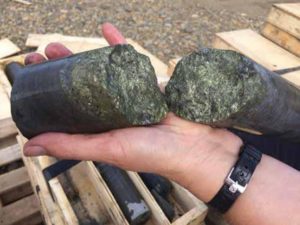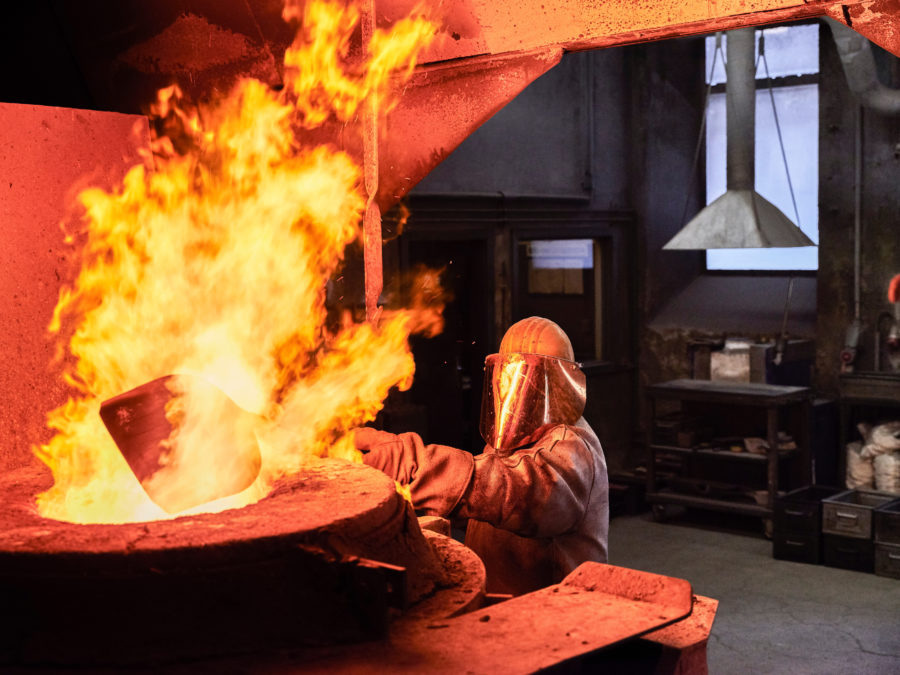Making the grade: understanding exploration results

Diamond drill core from the Freegold Ventures Shorty Creek Project in Alaska. Note the massive chalcopyrite (copper) mineralization. Photo courtesy Freegold Ventures Ltd
The most exciting news from a mining exploration stock is a high-grade drilling result. But what constitutes a good assay? It varies from situation to situation and commodity to commodity. Listed below is some rule of thumb information on interpreting drill results for investors.
The first thing investors must under-stand is that high-grade mineralization is relative to the depth of the intersection and relative to the size of the intersection. Today’s mining technology allows mining on a vast scale, with large open pits and huge 200-tonne mining trucks capable of processing large volumes of ore at a low cost. This is possible, provided the zone is near surface and the ore zone is large enough to be mined in bulk. Open pits are generally less than 300 metres deep and are several hundred metres in diameter. Two questions to ask are:
• Is the zone less than 300 metres deep?
• Is the drill intercept over 100 metres thick?
If both of these questions can be answered ‘yes’, then the threshold for what constitutes ‘high-grade’ will be dramatically lower. As a rule of thumb, open pit mining can process ore for $10 per tonne and, where the ore grade is more than double that at $20 per tonne, results would be economic. Consider that 1% of a metric tonne is 22 pounds. Then, for a commodity worth about $1 per pound such as zinc, 1% zinc worth $22 per tonne becomes interesting. Grades triple that, worth $66 per tonne when less than 300 metres deep and more than 100 metres thick, would be considered high-grade.
Using the same dollar figures for mining, but considering other commodities, here are some high-grade intercepts for other commodities and a few recent examples.
COPPER: Anything over 100 metres and 1% copper equivalent or better is considered to be high-grade. For example, Serengeti Resources announced 119.6 metres of 0.9% copper equivalent (copper plus gold values added together) at depths from 180 to 300 metres. The stock then increased from $0.30 to $1.50 after those drilling results were reported.
NICKEL: This valuable metal doesn’t usually occur in nature as a bulk tonnage target since most bulk tonnage mines contain 100 million tonnes of ore or more, and most hard rock nickel deposits are less than 10 million tonnes in size. Therefore, anything over 20 metres in thickness (significantly less thickness than other commodities) and 2% nickel grade or better would be reasonably considered high-grade. Example: In September 2007, Noront Resources released two nickel intercepts from shallow drilling between 80 metres and 150 metres deep, with a section of 71 metres grading 1.8% nickel and 1.5% copper. The stock moved from $0.80 to $4.00.
GOLD: It is usually reported in grams per tonne (or g/t), although sometimes, in the US, it is in oz/ton. A gram of gold is worth about $25, so 2 grams or better would be viewed as high-grade for bulk tonnage mining. One hundred metres of good grade is again good criteria for thickness.
As a spectacular example, Aurelian Resources announced intercepts of 216 metres grading 12.8 grams gold/tonne from its Fruta Del Norte deposit in Ecuador, now owned by Lundin Gold. This result is truly exceptional in terms of grade and thickness, and propelled the stock from $2 to over $22 in 2006. However, this extreme grade and thickness only comes along once every 10 years or so.
URANIUM: Uranium has traded in a wide range over the last 10 years, being negatively impacted by the shutdown of the nuclear industry in Japan. It is sold under long term contracts with undisclosed prices so it is difficult to know a reliable reference price. I would use $50 per pound as a long term price and suggest that an open pit target that grades 2.2 pounds/tonne, or approximately 0.1% would be an economic intercept over 100 metres. For high-grade, underground deposits, a grade of 1% would be a significant intercept over thicknesses of 2 metres or more.
DIAMONDS: Economic diamond mines are generally small even though they are commonly shallow deposits mined by open pits. The contained value per tonne can be extremely high, but varies from deposit to deposit, depending on the quality and size distribution of the contained diamonds. Larger diamonds are much more valuable than smaller ones, and consequently, two diamond deposits with the same grade, which contain different proportions of large stones, will vary significantly in their value per tonne of ore.
As a general rule of thumb, 1 carat/tonne of ore is viewed as high-grade. The geometry is important. Diamond pipes are carrot-shaped, vertically inclined bodies that come to surface and can be mined by open pits, and then, if the grade is high enough, can also be mined from underground. Diamond pipes are usu-ally comprised of a rock called kimberlite which gushed up from deep in the earth carrying diamonds. The diamonds were not ‘born’ in the kimberlite; it is only a medium of transport. The diamonds that survived the long voyage to near surface are found in what is called the diamond stability zone. Diamonds can often occur in dykes, and these are much less preferable for mining due to the limited thickness of the bodies. So look for grades approaching 1 carat/tonne and a description that the sample comes from a pipe rather than a dyke.
In early stage diamond exploration, values are presented as a diamond count rather than a grade. Here the rule of thumb is to have a minimum of one diamond per kilogram sample. One example was Diamonds North Resources, which reported results of 551 diamonds in an 81.75 kilogram sample, for a diamond count of approximately seven diamonds per kilogram sample. This is seven times greater than what we hold as our rule of thumb, and so it’s not surprising that the stock went up over 100% from $0.75 to $1.80 in the day following the release of this result. However, there were not enough commercial-sized diamonds and the project is now on hold.
UNDERGROUND MINING OR SMALL TONNAGE SCENARIOS
Now consider smaller tonnage scenarios, where the thicknesses are much less than 100 metres, but still at least 2 metres thick. These geometrics can be mined by under-ground mining technologies, and the costs are considerably higher, say $25 to $50 per tonne as a rule of thumb. In this style of mining $100 per tonne gross metal value is interesting and $500 per tonne is considered to be high-grade.
Again, considering 1% of a tonne equals 22 pounds then we would need 4.5% zinc to be interesting and 10% zinc to be high-grade. Since zinc deposits are generally flat, and bedded layers have thicknesses of less than 100 metres, we are generally looking for 10% or better. Using $500 per tonne gross metal value as a high-grade metal value on a per tonne basis gives the following parameters for other commodities:
COPPER: 10% copper would be very high-grade, but very often copper occurs with other base and precious metals, so I would consider a value of 5% copper to be a rule of thumb threshold for thicknesses of 2 metres and up. The Nevsun Resources Timok Project in Serbia has indicated resources for the Upper Zone estimated to be 1.7 million tonnes averaging 13.5% copper and 10.4 g/t gold – exceptionally high grades. The Ivanhoe Mines Kakula deposit in the DRC has returned very high copper grades, including 11.91 metres (true width) of 6.23% copper at a 3.0% copper cut-off.
GOLD: One ounce, or roughly 30 grams/tonne is high-grade and can be expected to move markets in most cases. Several ounces of gold per tonne is considered to be high-grade for underground mining, although 5 grams gold/tonne is usually economically viable. The most well-known example of narrow high-grade is in Goldcorp’s Red Lake, Ontario mine where gold grades of 18-20 grams gold/tonne are being mined from its deep workings.
URANIUM: The Athabasca Basin in northern Saskatchewan has high-grade uranium which can run from 1-3% uranium and higher in deposits buried 200 metres or more below surface. These are among the highest grade uranium mines in the world, so we will define 1% uranium as high grade for small tonnage style deposits. Fission Uranium has reported fantastically high grades at its Triple R deposit, including hole PLS16-504 on zone R840W with 25.95% U3O8 over 4.0 metresand 10.03% U3O8 over 11.0 metres. DIAMONDS: There is no separate rule of thumb I can define for small tonnage high-grade diamond deposits as to carat value, or diamond counts; the rule stated previously of one carat/tonne should suffice for all scenarios.
PLATINUM AND PALLADIUM:
These precious metals almost always occur as narrow seams, and one would look for grades of 6 grams platinum + palladium/ tonne over 2 metres as a reasonable thresh-old for high-grade.
The previous guidelines should give the reader a general idea of what is high-grade in a news release. It is important to think of assays in terms of what they mean in dollars per tonne, using the idea that a deposit is generally profitable if the metal value is twice the mining cost. Also it is necessary to determine if the deposit can be mined as a bulk tonnage or low tonnage project before considering whether a news release ‘makes the grade’ or not.
by Alf Stewart
Published with permission of Resource World Magazine
{{ commodity.name }}
{{ post.title }}
{{ post.date }}



Comments